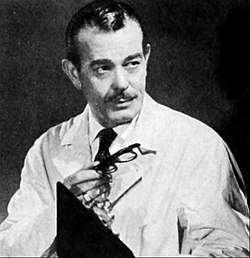Melville Ruick
Melville Ruick (July 8, 1898 - December 24, 1972) was an American actor.

Early years
Ruick was born in Boise, Idaho in 1898. His father was a U.S. district attorney in Idaho,[1] and Ruick studied law at the University of California.
Military service
World War I changed Ruick from a student lawyer to a student pilot. Ruick won his wings in the Air Service, Signal Corps, two weeks before the end of the war. He was the United States' youngest flier in the war at age 17 and became a lieutenant at age 18.[1]
During World War II, Ruick returned to uniform as a captain in the USAFF, attached to the Radio Production Unit as a producer-director.
Career
Ruick worked five years as master of ceremonies for the Fanchon and Marco shows.[1]
During the Great Depression, Ruick doubled as a bandleader and as an actor in theatrical stock. An offer came from CBS to work as a local radio announcer while Ruick was leading a dance band in Los Angeles. He later won an audition for the spot of announcer on the CBS radio show Lux Radio Theater,[2] staying with the show for 6 years.
After World War II, Ruick reentered show business, touring with Leo Carrillo in a revival of The Bad Man. While trying his luck on Broadway, Ruick received an offer to direct Paul Whiteman’s radio show for the National Guard.
Ruick starred as Chief John Randolph on the NBC adventure series The Door with No Name (1951)[3]:278 and as Dr. Barton Crane on the dramatic series City Hospital (1951) on ABC-TV[3] and CBS radio.[4] He also guest-starred in a number of popular 1960s shows such as The Fugitive, The Wild Wild West and The Invaders.
Personal life
He was married to actresses Lurene Tuttle and Claire Niesen (the former of whom he had a daughter with, actress Barbara Ruick).[5] He was also the father-in-law of composer-conductor John Williams and the maternal grandfather of Joseph Williams.
Death
Ruick died in Los Angeles on December 24, 1972, aged 74.
References
- Whitaker, Alma (June 7, 1931). "Two Leads for Mrs. Fiske". The Los Angeles Times. California, Los Angeles. p. Part III - 11. Retrieved July 29, 2018 – via Newspapers.com.

- "Say Hello to ..." (PDF). Radio and Television Mirror. 13 (5): 45. March 1940. Retrieved 23 February 2015.
- Terrace, Vincent (2011). Encyclopedia of Television Shows, 1925 through 2010 (2nd ed.). Jefferson, N.C.: McFarland & Company, Inc., Publishers. p. 190. ISBN 978-0-7864-6477-7.
- Terrace, Vincent (1999). Radio Programs, 1924-1984: A Catalog of More Than 1800 Shows. McFarland & Company, Inc. p. 77. ISBN 978-0-7864-4513-4.
- "Claire Niesen, Favorite Of Soap Opera Fans, Dies". The San Bernardino County Sun. California, San Bernardino. Associated Press. October 6, 1963. p. 21. Retrieved July 28, 2016 – via Newspapers.com.
